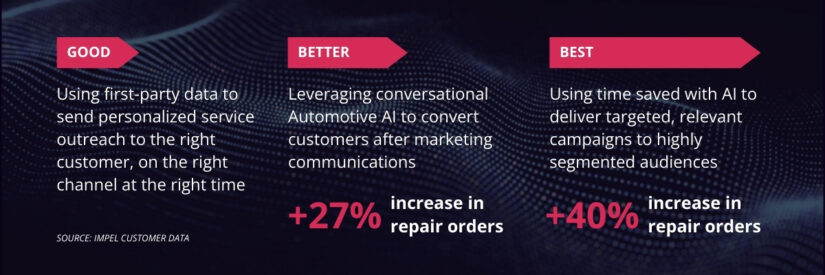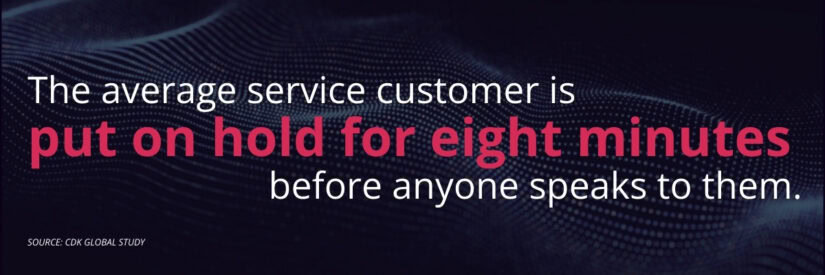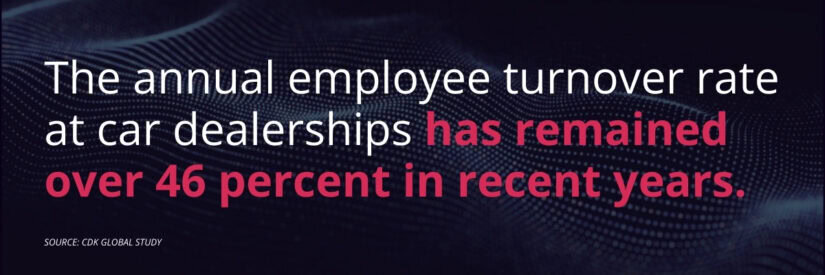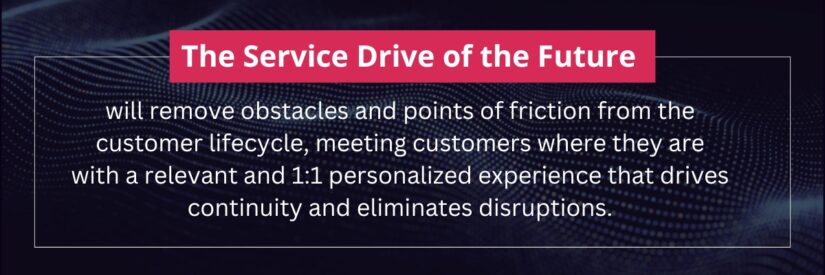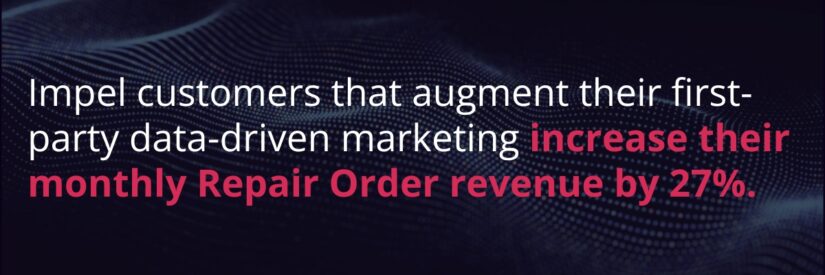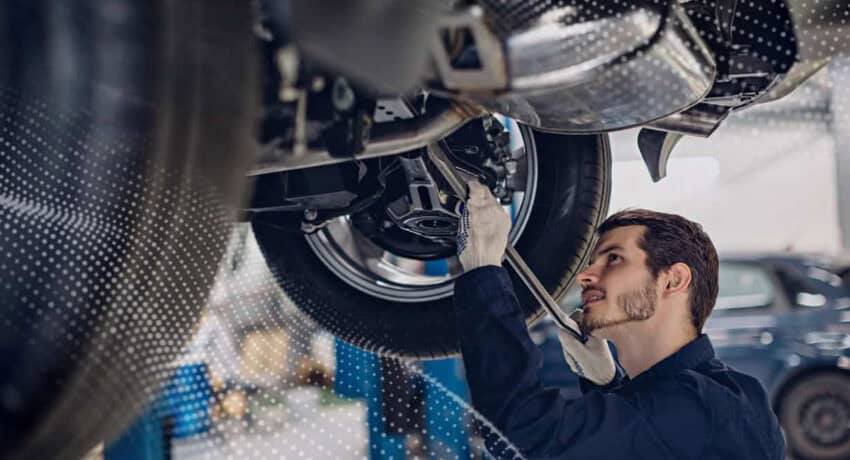
The state of vehicle ownership is evolving as rapidly as the technology inside modern vehicles. With advances in vehicle durability and sophistication, combined with rising new car MSRPs and high interest rates, people are holding onto their cars longer than ever before. In fact, the average car on the road is a record-breaking 12.5 years old, contributing to a greater need for vehicle service. At the same time, recalls have increased by 46% in recent years (Source: National Highway Traffic Safety Administration), reminding dealerships everywhere that focusing on the service drive is a critical strategy for sustained profitability. It’s also the engine that drives customer retention, loyalty, and repurchase – but only if the service experience meets customers’ expectations.
Where do dealerships fall short of customer expectations?
Sitting on enough first-party data to get personal but mass marketing anyway
Dealerships have an incredible wealth of first-party customer data —from personal details and preferences to vehicle-specific information—yet many still rely on generic, mass-marketing tactics. An ideal customer experience consists of timely and relevant communications tailored to the customer’s personal details and vehicle history. Instead, the vast majority of customers contend with impersonal marketing, like mass emails or generic direct mail, often arriving at arbitrary times.
By replacing mass marketing with hyper-personalized and timely communications, dealerships can transform customer frustration into appreciation. When customers receive tailored notifications about upcoming service milestones, recalls, inspections, or relevant offers, delivered at the right place and time, they feel valued and understood. As a result, they’re far more likely to consistently choose the dealership over an independent repair shop. Personalized auto service AI communications are not only more effective in driving engagement, they reduce customer opt-outs by 4x compared to generic messaging (Source: Impel customer data).
Scheduling stress
Dealers often invest tens of thousands of dollars each month in service marketing with one primary goal: booking appointments. However, the booking process is notoriously painful across the board. The average customer is put on hold for eight minutes before anyone speaks to them (Source: CDK Global), and most online forms require pages of detailed information that the customer has previously provided, increasing abandon rates.
Convenience is one of the main factors that determine whether customers choose a repair shop or dealership, so streamlining this traditionally fragmented process should be a top priority for every service drive.
Demo Impel’s concierge service scheduling solution
Staff turnover and shortages
High turnover and staff shortages in the dealership service drive make it challenging to train employees effectively and maintain consistent processes—key elements of a positive customer experience. Service advisors juggle planning for future appointments while assisting current customers in person and on the phone. Staff expertise and OEM certification are some of the main reasons customers choose dealership service drives over independent repair shops, but limited access to knowledgeable advisors can lead to frustration and disappointment.
Can dealership service drives deliver what customers want?
Dealerships that anticipate their customers’ current and future needs with a comprehensive and proactive ownership experience are gaining market share. Repair shops with convenient locations and strong reputations remain the most common choice among vehicle owners. Still, the gap in Net Promoter Score (NPS) between repair shops and dealership service drives has shrunk—from an 11-point difference in 2023 to just seven points in 2024. However, dealership customer defection remains high, with 80% of customers defecting after their warranty expires (Source: Digital Dealer).
Dealerships that are closing this gap are creating service experiences that offer the seamless convenience, personalization, and continuity customers expect. Today’s consumers, after all, are accustomed to ordering groceries, scheduling home repairs, and buying almost anything they need with a few taps in apps that personalize their experience based on their past behavior and demonstrated preferences.
How dealerships are building the service drive of the future, today
Dealerships with a loyal customer base and high service absorption rate operate differently. They see themselves as customer service centers that happen to sell cars, and they drive profitability by leveraging AI to elevate the customer experience and help their teams function more efficiently:
AI-powered concierge service
Effective service outreach requires far more steps than humans can possibly accomplish across tens of thousands of customer records. AI allows dealerships to engage in personalized, proactive outreach that anticipates needs and understands the best time and place to reach each customer.
This high-touch service approach operates as a concierge for vehicle owners, enhancing loyalty and retention with:
- Personalized incentives and service reminders
- Easy, instant scheduling on the customer’s channel of choice
- Transparency throughout the service appointment (vehicle status, photos/videos)
- Better clarity on what services are recommended and why
AI assistants for every service advisor
AI assistants are transforming the service advisor role by handling routine tasks and streamlining customer interactions. Since adding headcount can only scale the service drive to a certain extent, and finding qualified candidates is challenging, dealerships are increasingly turning to AI to fill these gaps. By offloading repetitive tasks to AI, staff can focus on higher-value interactions, aided by data-rich customer profiles that optimize their time and improve the customer experience.
Service teams are redirecting the time they save with AI to:
- Meet new customers who have just purchased a vehicle to help avoid defection
- Greet service customers and show them around the waiting room
- Provide more personalized service and relationship building during and after the service appointment
- Explain what services they are recommending and why
- Identify and convert service customers to sales opportunities
And this is just the beginning. In the near future, service departments will operate with a central unified AI operating system at the core of their tech stack and operations, seamlessly working alongside service team members to optimize customer interactions from start to finish. Automotive AI will proactively contact customers, schedule appointments, assist advisors and technicians with real-time insights, and follow up after service. The result will be a more responsive, efficient, and personalized service experience that maximizes convenience for customers and productivity for dealerships.
The ROI of a Modern Service Drive
Investing in the Service Drive of the Future provides measurable benefits, including:
Increased ROs
With streamlined processes and proactive outreach, dealerships can expect a rise in Repair Order quantity and revenue. Impel customers that augment their first-party data-driven marketing increase their monthly Repair Orders by 27%.
Additional reading: AI Impact Report
Reduced labor costs
Today, AI can take on the mundane and repetitive work that bogs service BDC reps and advisors down. Eventually it will take on the majority of routine, low-value, or administrative tasks typically handled by service personnel, enabling managers to focus on hiring quality talent and driving productivity. This shift can also free up capital that can be used to invest in existing employees or to enhance the customer experience – whether it is reinvested into waiting room facilities, loaner vehicles, mobile service, or other offerings that would attract and retain customers.
Improved customer lifetime value
74% of car buyers whose vehicle was serviced by the dealership of purchase are likely to return there to buy their next vehicle. (Source: Cox Automotive) Engaging service customers on a regular basis with the right messaging keeps customers coming back for service – making repeat purchases a natural next step when the time is right.
Get more details on the dealerships’ return on AI investments
Future-proofing the service drive today
The Service Drive of the Future is here, and forward-thinking dealerships are already capitalizing on AI’s transformative potential. By embracing Automotive AI now, they’re not only enhancing today’s customer experiences but also futureproofing their operations. AI can personalize outreach, streamline routine tasks, and provide deep customer insights that empower staff to build lasting relationships. Dealerships that seize these opportunities are transforming their service drives into customer loyalty hubs, positioning themselves to thrive regardless of future changes. For those yet to adopt, the race is on to keep pace with these innovations and create a service experience that will increase dealership revenue and profitability.
Following Impel’s acquisition of Outsell, these two powerhouse platforms are joining forces to create an Automotive Retail Operating System. By merging rich consumer insights with industry-leading generative Automotive AI, dealers can set a new standard for customer loyalty—engaging and inspiring each customer, at every stage of their journey, through truly personalized automation.
Experience what the industry’s only end-to-end AI Operating System can do for your dealership today — request a demo.
